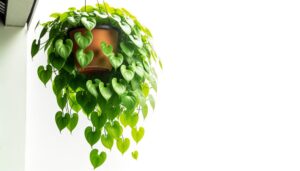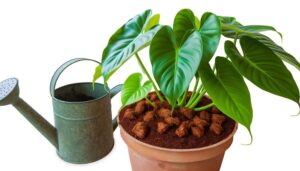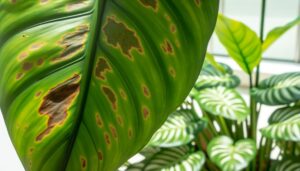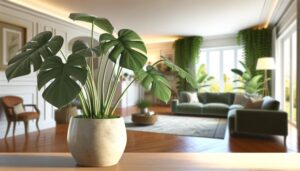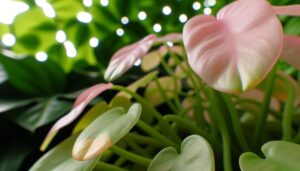What Is the Growth Rate of a Philodendron Birkin?
Under ideal conditions, the Philodendron Birkin displays a growth rate of 6 to 12 inches per year. This growth is supported by maintaining humidity levels of 60% to 80% and consistent temperatures between 65°F and 75°F.
Utilizing well-draining soil with a pH range of 5.5 to 6.5 and applying a balanced 20-20-20 NPK fertilizer bi-monthly further enhances growth. Adequate light exposure of 1000 to 2000 foot-candles and regular watering when the top 1-2 inches of soil are dry are essential.
To maximize the plant's potential, ensure these specific conditions are consistently met. Discover additional insights on maximizing growth.

Key Takeaways
- Philodendron Birkin typically grows 6 to 12 inches annually under optimal conditions.
- Ideal humidity levels for growth are between 60% to 80%.
- Consistent temperature range for best growth is 65°F to 75°F.
- Regular fertilization with a 20-20-20 NPK ratio every 4 to 6 weeks supports growth.
- A well-draining soil mix with a pH of 5.5 to 6.5 is essential for healthy growth.
Typical Growth Rate

Under ideal conditions, the typical growth rate of a Philodendron Birkin is approximately 6 to 12 inches per year. This growth rate is contingent upon several factors, including suitable humidity levels ranging from 60% to 80%, consistent temperatures between 65°F and 75°F, and well-draining soil with a pH of 5.5 to 6.5.
Empirical studies indicate that maintaining these parameters promotes vigorous vegetative growth. Additionally, regular application of a balanced, water-soluble fertilizer, ideally with a 20-20-20 NPK ratio, every 4 to 6 weeks, further supports this growth rate.
It is essential to monitor environmental conditions closely, as deviations can impede the plant's development and reduce its annual growth increment. Consequently, understanding these variables is fundamental for successful cultivation.
Light Requirements
Ideal light conditions play a significant role in achieving the typical growth rate of 6 to 12 inches per year for a Philodendron Birkin. Best light exposure ranges from 1000 to 2000 foot-candles, which equates to bright, indirect sunlight. Excessive direct sunlight can lead to chlorophyll degradation, whereas insufficient light can hinder photosynthesis, thereby stunting growth. For best results, situate the plant near east or west-facing windows, ensuring filtered light conditions.
| Light Intensity | Effect on Growth |
|---|---|
| > 2000 fc | Leaf burn |
| 1000-2000 fc | Best growth |
| < 1000 fc | Reduced growth |
Research indicates that maintaining consistent light levels within this range maximizes photosynthetic efficiency and promotes robust development of the Philodendron Birkin.
Watering Needs
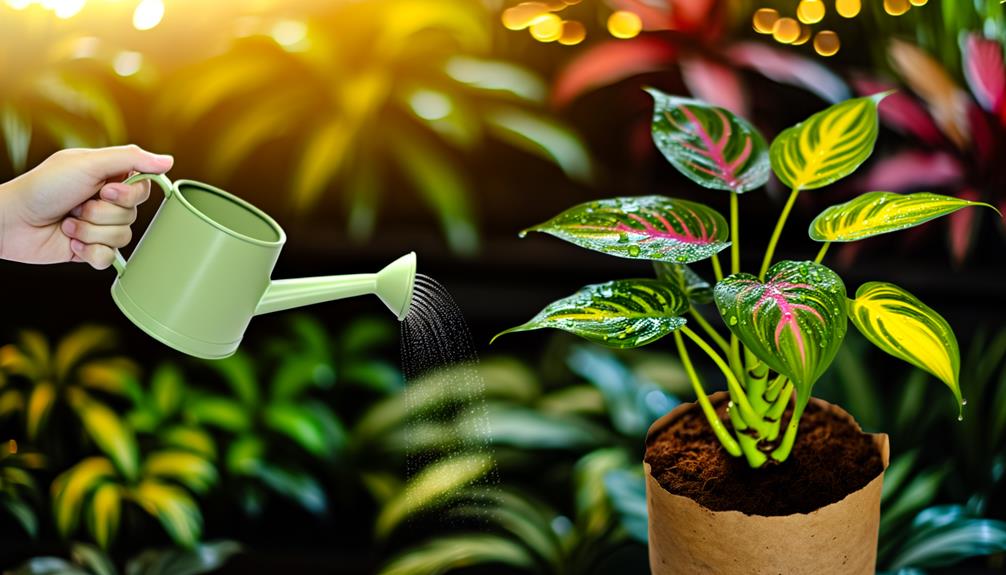
Maintaining ideal hydration for a Philodendron Birkin involves watering when the top 1-2 inches of soil are dry, ensuring a balance between moisture retention and aeration.
Consistent moisture levels are crucial for best growth, avoiding both waterlogging and drought stress. Overwatering can lead to root rot, a condition harmful to the plant's health. According to research, Philodendron species thrive with a watering frequency that aligns with indoor humidity levels, typically requiring irrigation every 7-10 days.
Employing a well-draining substrate enhances water movement, preventing stagnation. Additionally, using room-temperature, non-chlorinated water aids in maintaining the plant's physiological processes.
Monitoring soil moisture with a hygrometer can provide precise hydration management, thereby promoting robust growth and overall plant vigor.
Soil and Fertilizer
A well-draining soil mix, comprising components such as peat, perlite, and orchid bark, is fundamental for best nutrient uptake and root health in Philodendron Birkin. This blend guarantees ideal aeration and prevents waterlogging, which can lead to root rot.
Research indicates that a pH range of 5.5 to 6.5 is perfect for nutrient availability. Fertilization should be carried out bi-monthly during the growing season using a balanced, water-soluble fertilizer with an N-P-K ratio of 20-20-20. Dilute the fertilizer to half the recommended strength to avoid nutrient burn.
Regular soil testing can help monitor nutrient levels and pH, guaranteeing the plant's growth conditions remain at their peak throughout the year.
Temperature and Humidity

Ensuring ideal temperature and humidity levels is crucial for the vigorous growth of Philodendron Birkin. Research indicates a temperature range of 65-80°F (18-27°C) and humidity levels of 60-80% as best for its development. Consistent exposure to these conditions promotes prime physiological processes such as photosynthesis and transpiration. Temperature fluctuations outside this range can impede growth, leading to stress and potential foliar damage.
Humidity is equally important for Philodendron Birkin's growth. Insufficient humidity can result in desiccation, while excessive humidity might encourage fungal infections. Employing humidifiers or humidity trays can help maintain appropriate levels. These controlled environmental parameters are necessary for sustaining the health and maximizing the growth rate of Philodendron Birkin in both household and greenhouse settings.
Pruning and Maintenance
Effective pruning and maintenance of a Philodendron Birkin are essential for best growth and health.
Routine removal of aging leaves prevents disease and enhances overall plant vigor.
Furthermore, strategic pruning can stimulate new growth and regulate plant size, aligning with horticultural best practices.
Removing Dead Leaves
Pruning dead leaves from a Philodendron Birkin is essential for maintaining ideal plant health and promoting vigorous growth. This practice reduces potential vectors for disease and pests, ensuring the plant allocates resources efficiently. Research indicates that removing necrotic foliage should be conducted using sterilized pruning shears, cutting close to the base of the leaf stem. Regular inspection, ideally bi-weekly, allows for timely intervention.
| Task | Frequency | Tools Needed |
|---|---|---|
| Inspect for dead leaves | Bi-weekly | Visual inspection |
| Prune dead leaves | As needed | Sterilized pruning shears |
| Sterilize tools | Before/After | Isopropyl alcohol |
This systematic approach not only curtails pathogen spread but also augments the plant's overall aesthetic and physiological robustness.
Encouraging New Growth
To encourage new growth in a Philodendron Birkin, it is essential to implement strategic pruning and maintenance practices based on scientific research and precise horticultural techniques. Pruning should be performed with sterilized tools to prevent pathogen transmission, ideally during the active growing season.
Target stems exhibiting elongated internodes or senescent leaves, cutting just above a node to stimulate axillary bud activation. Additionally, maintaining ideal environmental conditions, such as 60-70% relative humidity and temperatures between 18-24°C, enhances physiological processes conducive to growth.
Regularly assess soil moisture levels, ensuring a balance that prevents both waterlogging and desiccation. Employing these evidence-based strategies will maximize vegetative proliferation and overall plant vigor, promoting robust and consistent new growth in Philodendron Birkin specimens.
Controlling Plant Size
Controlling the size of a Philodendron Birkin requires systematic pruning and maintenance practices based on horticultural research and empirical evidence. Pruning should be conducted using sterilized, sharp pruning shears to minimize pathogen transmission. Cut back stems to a node, approximately 1-2 cm above the leaf axil, ensuring a 45-degree angle to facilitate ideal healing and reduce water retention on the cut surface.
Regular removal of yellowing or senescent leaves promotes healthy growth. Maintenance involves monitoring for pests and applying appropriate treatments, ensuring consistent humidity levels around 60-70%, and providing balanced, water-soluble fertilizers at bi-monthly intervals.
Implementing these scientifically-backed strategies allows for controlled growth while maintaining the plant's aesthetic appeal and physiological health.
Conclusion
Coincidentally, the best conditions for Philodendron Birkin growth—sufficient light, regular watering, nutrient-rich soil, and controlled temperature and humidity—align with those suggested for maximizing the health of most tropical decorative plants.
The species shows a moderate growth rate, flourishing particularly well when environmental factors are carefully managed. Regular trimming and upkeep further improve its growth, underlining the crucial role of thorough care.
Consequently, focus on detailed horticultural practices guarantees strong growth and health in Philodendron Birkin specimens.


